
ATTENTION: The works hosted here are being migrated to a new repository that will consolidate resources, improve discoverability, and better show UTA's research impact on the global community. We will update authors as the migration progresses. Please see MavMatrix for more information.
Show simple item record
| dc.contributor.author | Blair, Terence Cletus | |
| dc.date.accessioned | 2021-02-12T13:41:21Z | |
| dc.date.available | 2021-02-12T13:41:21Z | |
| dc.date.issued | 1981-07 | |
| dc.identifier.uri | http://hdl.handle.net/10106/29691 | |
| dc.description.abstract | The Todos Santos Formation at Jerico was deposited as an alluvial fan system by high gradient, short duration ephemeral streams which transported gravel, sand, and mud northeastward through a feeder canyon which opened out onto an alluvial plain. This alluvial fan system is composed of streamflood, debris flow, and braided stream deposits. Three distinct alluvial fan environments were distinguished at Jerico: proximal fan facies, mid-fan facies, and distal fan facies. Analysis of the vertical succession of these depositional facies reveals two proximal to distal alluvial fan transitions separated by a distal to proximal transition. This suggests that a period of alluvial fan progradation separates two periods of alluvial fan recession. The Todos Santos sandstone compositions and conglomerate clast assemblages can be attributed to four source rock units: the metamorphic-igneous basement rocks now exposed as the Chiapas massif; the Santa Rosa Group, a late Paleozoic sequence of predominantly marine sedimentary rocks; unnamed volcanic rocks found at the base, and interbedded with, the Todos Santos Formation; and the Todos Santos Formation itself. The lowermost conglomerate clast assemblage suggests that the channel network had already exposed the granitic batholith rocks of the Chiapas massif. Clasts from the debris flow sequence, which composes the central part of the Jerico section, indicate that source rock includes the meta-igneous complex, the Santa Rosa Group, and the unnamed volcanic rocks. Sandstone composition-and conglomPrate clasts from the upper portion of the Jerico section suggest that diminution of Santa Rosa outcrops in the source area had occurred by that time. An abundance of debris flows, the presence of pedogenic carbonate nodule horizons, red coloration, and its lateral transition into evaporite deposits suggest that the Todos Santos Formation was deposited under arid to semi-arid climatic conditions. Palynologic evidence points to a Neocomian time of deposition. The vertical succession of facies at Jerico combined with regional evidence suggest that deposition of the Todos Santos Formation was tectonically controlled. These sedimentary rocks were eroded off horst blocks and deposited in adjacent subsiding grabens or half-grabens. Graben formation may be associated with rifting and later subsidence of the Gulf of Mexico basin. | en_US |
| dc.language.iso | en_US | en_US |
| dc.publisher | University of Texas at Arlington Libraries | en_US |
| dc.subject | Alluvial fans - Chiapas, Mexico | en_US |
| dc.subject | Lithofacies - Chiapas, Mexico | en_US |
| dc.subject | Palynology - Chiapas, Mexico | en_US |
| dc.subject | Alluvial fans | en_US |
| dc.subject | Lithofacies | en_US |
| dc.subject | Palynology | en_US |
| dc.subject | Chiapas, Mexico | en_US |
| dc.title | Alluvial Fan Deposits of the Todos Santos Formation of Central Chiapas, Mexico | en_US |
| dc.type | Thesis | en_US |
| thesis.degree.department | Environmental and Earth Sciences | |
| thesis.degree.name | Masters of Science in Geology | |
Files in this item
- Name:
- PDF
- Size:
- 30.22Mb
- Format:
- PDF
This item appears in the following Collection(s)
Show simple item record


